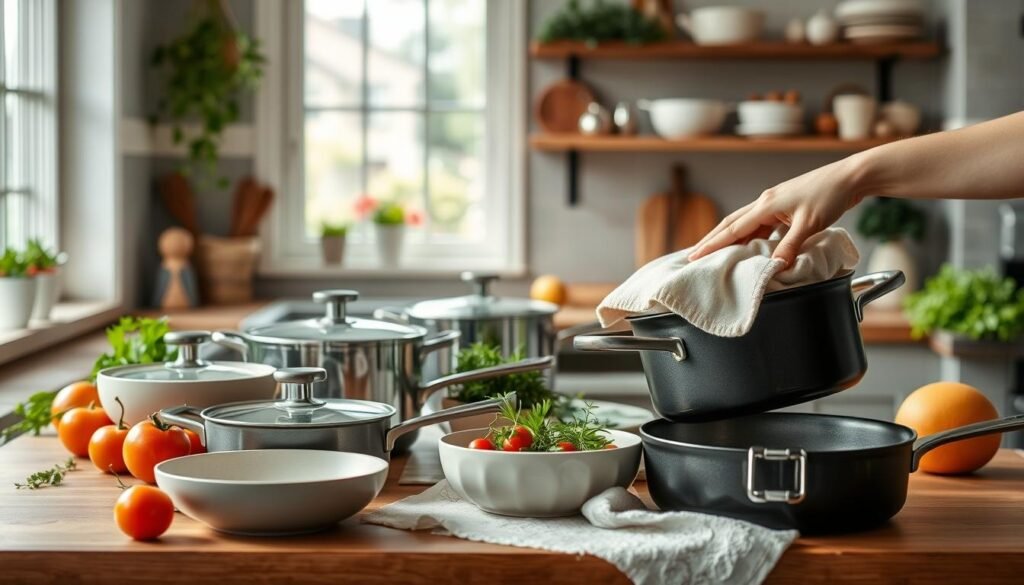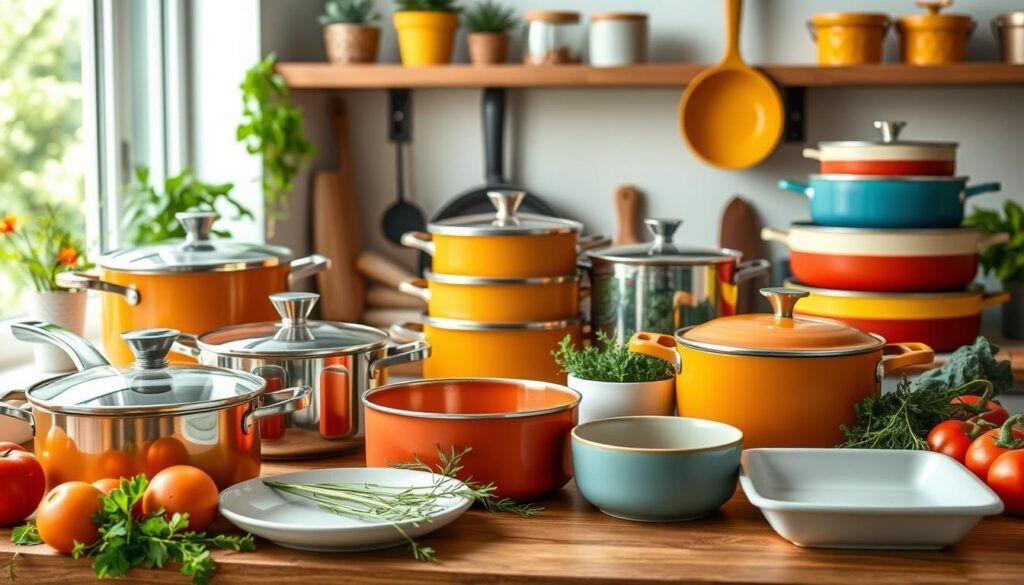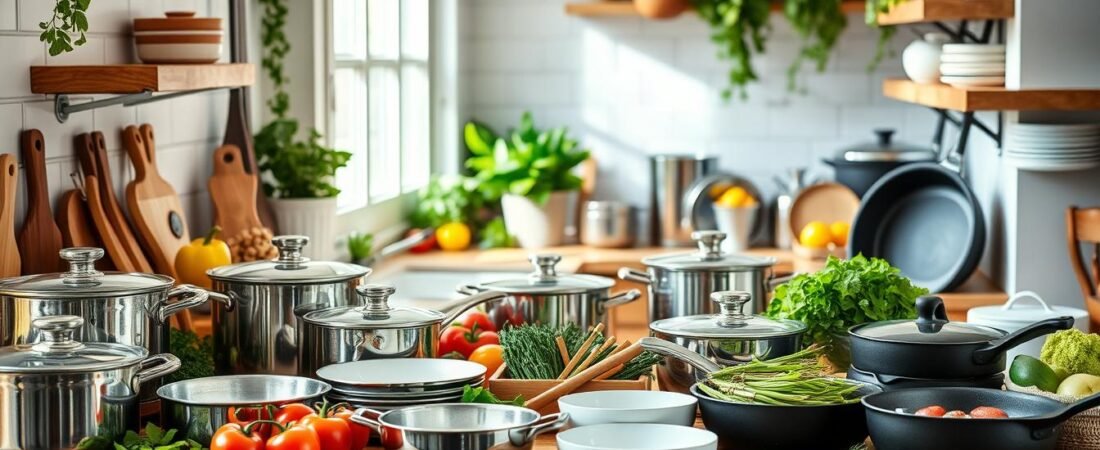Spending more time in the kitchen means we need to choose our cookware wisely. Opting for chemical free cookware is key to healthy cooking and avoiding toxins1. Many are turning to stainless steel and cast iron for their non-toxic benefits.
Chemical free cookware removes heavy metals and harmful substances. This makes it a healthier choice for cooking2.
There are many safe cookware options. Stainless steel and cast iron stand out for their durability and safety. They prevent harmful substances from leaching into food1.
Key Takeaways
- Chemical free cookware is a healthier alternative to traditional cookware options
- Stainless steel and cast iron cookware are popular choices for non-toxic kitchenware
- Chemical free cookware can reduce the risk of toxic exposure and promote healthy cooking
- Stainless steel is noted for its long-lasting durability and non-reactivity, preventing leaching into food1
- Cast iron cookware naturally becomes non-stick over time through seasoning, eliminating synthetic coating needs1
- Chemical free cookware is designed to eliminate heavy metals and harmful residues, making it a great option for those looking for a healthier cooking alternative2
Understanding Chemical Free Cookware and Its Importance
Chemical-free cookware doesn’t have harmful chemicals like PFAS and PTFE. These can get into your food and harm your health3. Traditional non-stick pans often have these chemicals. They can raise your cholesterol and change your liver enzymes3.
On the other hand, eco-friendly pots and pans are safe. They’re made from stainless steel, cast iron, and ceramic. These materials are non-toxic and good for cooking.
Using chemical-free cookware has many benefits:
- It lowers the risk of health problems from PFAS and PTFE3
- It’s non-toxic and safe for cooking, perfect for healthy cooking utensils
- It’s durable and lasts long, so you don’t need to replace it often
When you’re looking for chemical-free cookware, choose stainless steel, cast iron, and ceramic. These materials are safe and last a long time4. Stay away from traditional non-stick pans, which might have harmful chemicals like PFOA and PTFE5. By picking eco-friendly pots and pans, you make cooking safer and healthier.
The Benefits of Stainless Steel Cookware
Stainless steel cookware is a top pick for many homeowners. It’s durable, safe, and easy to clean6. It also stands up to scratches and corrosion, making it a smart choice for kitchens. Plus, it’s often free from BPA, perfect for those seeking sustainable kitchen appliances.
Stainless steel cookware excels at even heat distribution. This means less burnt food and more evenly cooked meals7. It’s also non-reactive, so acidic foods won’t change the taste of your dishes8.
Some key benefits of stainless steel cookware include:
- Durability and resistance to scratches and corrosion
- Easy to clean with hot water, soap, and a gentle sponge
- Non-toxic and non-reactive, making it safe for cooking with acidic ingredients
- Even heat distribution, minimizing hot spots and burnt food
In summary, stainless steel cookware is ideal for those wanting bpa-free cookware that’s also sustainable and simple to care for6. Its durability, safety, and even heat make it a valuable addition to any kitchen.
Cast Iron Cookware: A Time-Tested Chemical Free Option
Cast iron cookware is a top pick for those looking for chemical free options. It’s safe and non-toxic, perfect for frying, baking, and braising9. The FDA keeps an eye on PFAs in nonstick cookware to ensure it’s safe when used right9.
There are many types of cast iron cookware, like seasoned and enameled. Seasoned cast iron is durable and can last decades with care10. Enameled cast iron has a protective enamel layer, making it rust-resistant and easy to clean. Brands like Lodge and Le Creuset offer a variety of products, including skillets, saucepans, and Dutch ovens10.
Using cast iron can boost your iron intake9. It’s also free from PFAS and other harmful chemicals, making it ideal for non-toxic kitchenware11. To keep your cast iron in good shape, season it often and avoid harsh cleaners or scourers10.
Here are some tips for seasoning and maintaining your cast iron cookware:
- Season your cast iron cookware regularly to prevent rust and maintain non-stick properties10.
- Avoid using abrasive cleaners or scourers, as they can damage the seasoning10.
- Use gentle soap and water to clean your cast iron cookware, and dry it thoroughly after washing10.
By following these tips and choosing the right cast iron cookware, you can enjoy the benefits of chemical free cookware and non-toxic kitchenware9. Always prioritize your health and safety when cooking. Choose cookware that matches your values11.
| Brand | Product | Price |
|---|---|---|
| Lodge | 10.25-inch Cast Iron Skillet | $20 |
| Le Creuset | 5-quart Cast Iron Dutch Oven | $200 |
Comparing Chemical Free Cookware Options for Your Kitchen
Choosing the right eco-friendly pots and pans is key for a safe kitchen. Healthy cooking utensils are crucial for a good cooking experience. Studies show that some non-stick cookware can release harmful plastics into food12. On the other hand, stainless steel and cast iron are great for their durability and safety13.
Here are some key factors to consider when comparing chemical-free cookware options:
- Material: Look for cookware made from stainless steel, cast iron, or ceramic14.
- Non-toxicity: Choose cookware that is free from harmful chemicals like PFOA and PFAS12.
- Durability: Consider the lifespan of the cookware and its ability to withstand high temperatures14.
When comparing cookware brands, some stand out more than others. For instance, Tramontina is known for its durability and heat resistance14. Calphalon is praised for its non-stick coating13. The best choice for you will depend on your cooking style and needs.
| Cookware Material | Non-toxicity | Durability |
|---|---|---|
| Stainless Steel | Yes | High |
| Cast Iron | Yes | High |
| Ceramic | Yes | Medium |
Essential Features to Look for in Non-Toxic Kitchenware
Choosing non-toxic kitchenware requires looking at several key features. These include material quality, safety certifications, and manufacturing standards. For example, bpa-free cookware is a top choice for those seeking non-toxic options. The rise of “nontoxic cookware” began with GreenPan’s PFAS-free ceramic nonstick pans in 200715.
When picking non-toxic kitchenware, consider these important aspects:
- Material quality indicators, such as the type of material used and its durability
- Safety certifications, such as BPA-free and non-toxic certifications
- Manufacturing standards, such as the country of origin and the manufacturer’s reputation
It’s also crucial to think about the environmental impact of your choices. Sustainable kitchen appliances can cut down on waste and lower your carbon footprint. Opting for non-toxic and sustainable kitchenware makes your kitchen healthier and greener16.
Finding the right non-toxic kitchenware can seem overwhelming. But by focusing on these key features, you can make a smart choice. This will help you create a healthier and more eco-friendly kitchen.
Maintaining Your Chemical Free Cookware
To keep your chemical free cookware in top shape, regular care is key17. This means cleaning, seasoning, and storing it right. Cleaning stops bacteria and contaminants from building up. Seasoning keeps the surface non-stick17. Storing it properly helps it last longer. For example, the Made In 12-Inch Stainless Steel Skillet can handle up to 800°F in the oven17.
There are many non-toxic kitchenware options out there. Stainless steel, cast iron, and carbon steel are good choices because they don’t have harmful coatings like PFAS17. The GreenPan Valencia Pro series, for example, has 11 pieces and can go up to 600°F in the oven. Its lids can handle up to 425°F18. The Caraway cookware set includes 9 pieces and can go up to 550°F in the oven18.
Here are some tips for keeping your chemical free cookware in great shape:
- Regularly clean your cookware with mild soap and water
- Season your cast iron cookware to maintain the non-stick surface
- Store your cookware in a dry place to prevent damage
By following these tips, your chemical free cookware will stay in good condition. This ensures healthy and safe cooking17. Nonstick cookware prices vary from $160 to $400, depending on the brand and features18. The GreenPan Valencia Pro series is known for its great performance and easy cleaning18.

In conclusion, taking care of your chemical free cookware is vital for its longevity and safety. By following the tips and choosing the right non-toxic kitchenware, you can enjoy safe and healthy cooking17. Nonstick cookware generally has a shorter lifespan than ceramic or cast iron18. Many users find that nonstick cookware is easy to clean with just a little scrubbing18.
Environmental Impact of Sustainable Kitchen Choices
Choosing eco-friendly pots and pans can greatly reduce our environmental impact19. Traditional cookware, like non-stick pans, harms habitats and pollutes due to metal mining19. On the other hand, materials like recycled stainless steel or cast iron need less replacement, cutting down on waste19.
Some important things to think about for a greener kitchen include:
- Choosing durable and long-lasting cookware to reduce waste
- Selecting healthy cooking utensils made from non-toxic materials
- Opting for eco-friendly pots and pans that are free from harmful chemicals
By making these choices, we help create a more sustainable future and lower our carbon footprint20.
Also, brands that use minimal, recyclable, or compostable packaging can greatly reduce kitchen waste19. Look for products with Green Seal or Cradle to Cradle certifications for high environmental and health standards19. Choosing sustainable cookware not only improves our cooking but also supports a healthier planet and reduces our ecological footprints21.
Best Practices for Cooking with Non-Toxic Cookware
Cooking with non-toxic cookware needs careful attention and following best practices. When using bpa-free cookware, keep the temperature in check and avoid high heat. This helps prevent harmful chemicals from being released22. Also, use silicone or wooden spoons to avoid scratching the cookware23.
Some key tips for cooking with non-toxic cookware include:
- Avoiding high heat and using gentle cooking techniques22
- Choosing the right utensils, such as silicone or wooden spoons23
- Regularly cleaning and maintaining the cookware to prevent the buildup of bacteria and other harmful substances24
By following these best practices and using sustainable kitchen appliances, you can lower your exposure to harmful chemicals. This makes cooking healthier. Also, investing in quality non-toxic cookware can make it last longer and reduce waste. This supports the idea of sustainable kitchen appliances22.

In conclusion, cooking with non-toxic cookware needs the right techniques, utensils, and upkeep. By adopting these practices and choosing bpa-free cookware and sustainable kitchen appliances, you can make cooking healthier and more sustainable24.
| Cookware Type | Benefits | Drawbacks |
|---|---|---|
| Ceramic | Non-toxic, easy to clean | May be prone to scratching |
| Stainless Steel | Durable, resistant to corrosion | May be noisy, expensive |
| Cast Iron | Durable, versatile | May be heavy, require seasoning |
Investment Value of Quality Chemical Free Cookware
Buying quality chemical free cookware is a smart choice for any kitchen. It offers a durable and safe way to cook that can last for decades with the right care25. Studies show that the best nonstick cookware is made from stainless steel, cast iron, or carbon steel. These materials work well if used right25.
Brands like GreenPan and All-Clad are top choices for many. They are known for their quality in both home and professional kitchens25.
Choosing non-toxic kitchenware means looking at the materials and how it’s made. Ceramic nonstick cookware lasts about one to three years before it stops working well25. But, stainless steel and cast iron can last a lifetime with the right care. Experts say nonstick pans without PTFE are safer and less likely to have harmful chemicals26.
Some top picks for chemical free cookware include:
- GreenPan’s ceramic nonstick frying pans, which are PFAS-free and highly rated25
- All-Clad’s D3 Stainless Steel Cookware, known for its high performance and durability25
- Uncoated pans from carbon steel and cast iron, which are unlikely to have PFAS26
Choosing quality chemical free cookware is good for your health and the planet. It also means you get a durable and safe way to cook26. With the right care, these options can last a lifetime. They are a wise investment for any kitchen.
Where to Buy Authentic Chemical Free Cookware in Canada
In Canada, finding authentic chemical-free cookware is easy. Online stores like Amazon have a big selection of eco-friendly pots and pans from well-known brands27. You can also check out specialty cookware stores like Meyer and SuperSteel for top-notch, non-toxic options28.
For example, the Meyer Nouvelle Stainless Steel 10-Piece Set is just $199.99, down from $699.9927. The Best Seller Cookware Set, with 12 pieces, has a 4.7 rating from 47,362 reviews and costs $395, originally $545, saving you $15028.
When looking for chemical-free cookware, keep an eye out for these features:
- Eco-friendly materials, such as stainless steel and non-stick coatings
- Healthy cooking utensils, such as silicone and wooden handles
- Price range guidelines, with options available from $50 to $500
Choosing authentic chemical-free cookware supports healthy cooking and sustainable kitchen practices27. With many options online and in specialty stores, finding the right set is simple28.
Conclusion: Making the Switch to Healthier Cooking
Switching to healthier cooking is great for your health and the planet. Choosing bpa-free cookware and eco-friendly kitchen tools helps avoid harmful chemicals. It also supports a greener future29.
Healthier cooking boosts nutrient intake and lowers disease risks. It’s a smart move for your health and the environment.
Quality chemical-free cookware might cost more upfront, but it’s a long-term gain for your health30. By switching, you protect your health and help the planet. Look for top brands and deals to find the right cookware for you.
Your health and the planet’s well-being are worth the investment. Start a healthier, greener cooking journey today2930.

